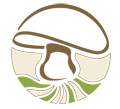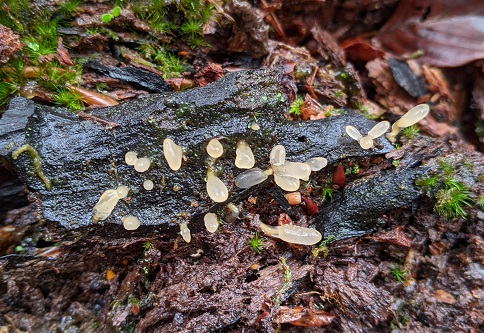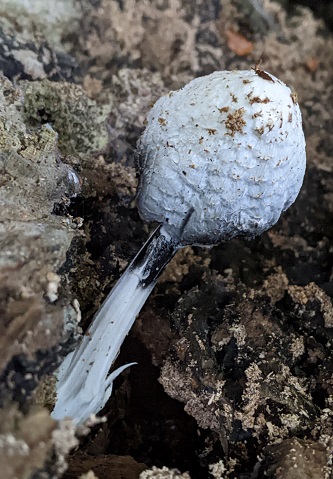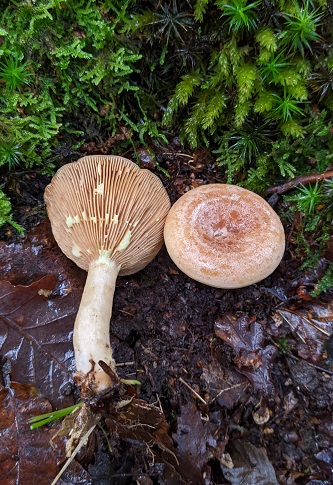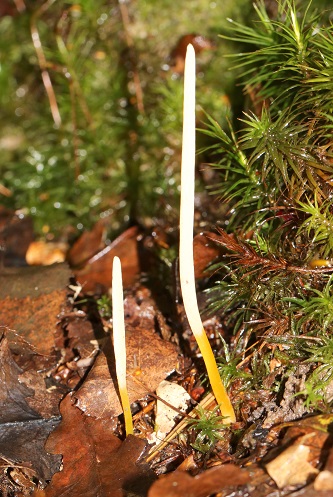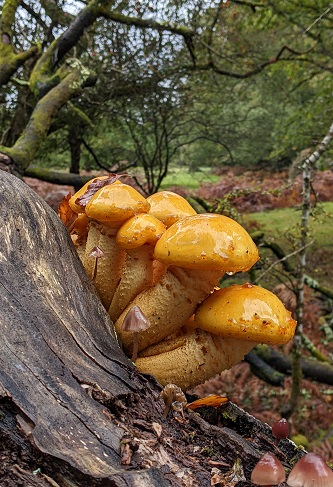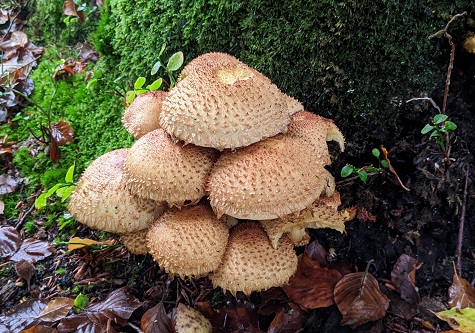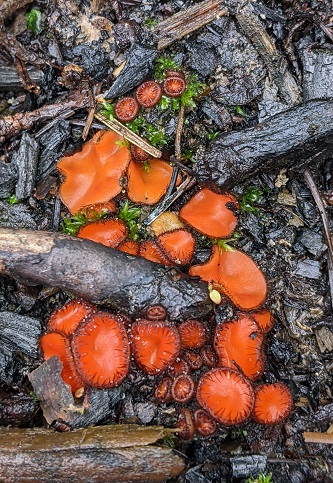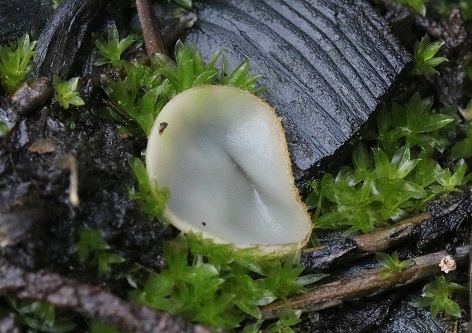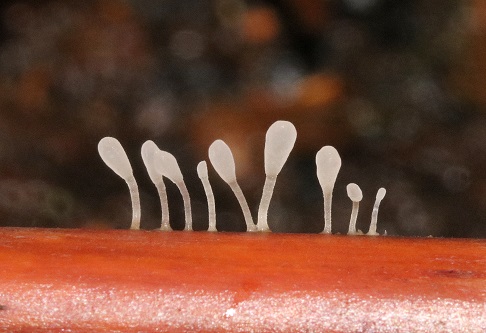Millyford Bridge
Sat 28 Oct 2023
Field event ID HF2322
OS Grid areas: SU2316
Report: Although rain was forecast, in the event, we just had to shelter a couple of times for brief showers. The mild, wet weather of late was reflected in the numerous fungal sporocarps on offer. In the morning session, we probably ventured no more than 400 metres from the car park.
Close to the river we found Mycena pseudocorticola (Steely Bonnet) on a moss-covered trunk, Leotia lubrica (Jellybaby) and what were thought to be Macrotyphula fistulosa (Pipe Club).
Beside the main gravel path there was an Alder bearing a fantastic tiered display of Mensularia radicata (Alder Bracket) and nearby we discovered Lactarius chrysorrheus (Yellowdrop Milkcap) and Russula fellea (Geranium Brittlegill).
We then climbed up to drier ground, where the finds kept coming. A nice troop of Hydnum repandum (Wood Hedgehog) and numerous Lactarius blennius (Beech Milkcap) were followed by Leccinum scabrum (Brown Birch Bolete) and Leccinum cyaneobasileucum (Greyshank Bolete). A Cortinarius (Webcap) with a very slimy beige cap and a lilac-stained stipe was probably C. mucifluoides but there was no doubt about a large specimen of Cortinarius bolaris (Dappled Webcap).
Many of the dead Bracken stems were host to rows of the tiny white Typhula quisquiliaris (Bracken Club), no more than 4mm high. Beneath the Bracken there were some Cortinarius violaceus (Violet Webcap) and Tricholoma sulphureum (Sulphur Knight).
A couple of rotting Beech stumps provided us with Phleogena faginea (Fenugreek Stalkball), Calocera pallidospathulata (Pale Stagshorn) and a very dark blue Entoloma (Pinkgill) species, a sample of which was collected for more detailed examination.
After lunch, most of the group then joined Russ on a longer walk to see the inkcap, Coprinopsis alnivora, that he recorded as new to Britain in 2022 and that had reappeared in the same beech rot-hole this year.
On the way, we stopped to admire a large group of Pholiota aurivella (Golden Scalycap) on a fallen Beech and paused at a patch of burnt ground where there were some Scutellinia scutellata (Common Eyelash) and a pale cup fungus, later identified as Trichophaea hemisphaerioides. Our arrival at the rot-holed beech coincided with the heaviest shower of the day but we admired the five fruiting bodies of the extremely rare inkcap. On the return walk, we spotted a clump of Pholiota squarrosa (Shaggy Scalycap) at the base of a tree.
Species recorded: Amanita citrina var. citrina, Amanita muscaria var. muscaria, Amanita olivaceogrisea, Amanita rubescens var. rubescens, Apioperdon pyriforme, Armillaria mellea, Ascocoryne cylichnium, Bjerkandera adusta, Boletus badius, Byssomerulius corium, Calocera cornea, Calocera pallidospathulata, Calocera viscosa, Cantharellus cibarius, Cantharellus tubaeformis, Chalciporus piperatus, Chlorociboria aeruginascens, Clavaria flavipes, Clavulina coralloides, Clavulinopsis helvola, Clitopilus hobsonii, Collybia cookei, Coprinellus micaceus, Cortinarius bolaris, Cortinarius elatior, Cortinarius flexipes var. flexipes, Cortinarius mucifluoides, Cortinarius rubellus, Cortinarius violaceus, Crepidotus cesatii, Crepidotus mollis, Cuphophyllus virgineus var. virgineus, Daedaleopsis confragosa, Exidia nucleata, Galerina marginata, Ganoderma adspersum, Gymnopus peronatus, Helvella lacunosa, Heterobasidion annosum, Hydnum repandum, Hymenopellis radicata, Hypholoma fasciculare var. fasciculare, Hypoxylon fragiforme, Infundibulicybe geotropa, Inocybe mixtilis, Inocybe petiginosa, Laccaria amethystina, Laccaria laccata, Lacrymaria lacrymabunda, Lactarius blennius, Lactarius chrysorrheus, Lactarius quietus, Lactarius serifluus, Lactarius subdulcis, Lactarius tabidus, Leccinum cyaneobasileucum, Leccinum scabrum, Leotia lubrica, Lycoperdon nigrescens, Lycoperdon perlatum, Marasmius hudsonii, Megacollybia platyphylla, Mensularia radiata, Mucidula mucida, Mycena abramsii, Mycena capillaris, Mycena epipterygia, Mycena erubescens, Mycena galericulata, Mycena galopus var. galopus, Mycena galopus var. nigra, Mycena haematopus, Mycena metata, Mycena olida, Mycena pelianthina, Mycena pseudocorticola, Mycena rosea, Mycena vitilis, Neobulgaria pura var. pura, Panellus stipticus, Phleogena faginea, Physisporinus sanguinolentus, Pleurotus ostreatus, Pluteus cervinus, Pluteus phlebophorus, Polyporus leptocephalus, Psathyrella piluliformis, Psilocybe fimetaria, Ramaria stricta, Resupinatus europaeus, Rhodocollybia butyracea, Rickenella fibula, Russula aquosa, Russula betularum, Russula claroflava, Russula fellea, Russula fragilis var. fragilis, Russula nigricans, Russula nobilis, Russula ochroleuca, Schizophyllum commune, Scleroderma citrinum, Scutellinia scutellata, Simocybe sumptuosa, Stereum hirsutum, Stereum subtomentosum, Tricholoma columbetta, Tricholoma fulvum, Tricholoma sulphureum var. sulphureum, Typhula quisquiliaris, Xylaria hypoxylon
A full species list with further details can be seen at the Fungal Records Database of Britain and Ireland (FRDBI). Please contact us if you need a user ID.
